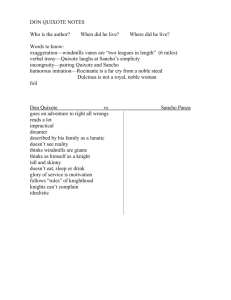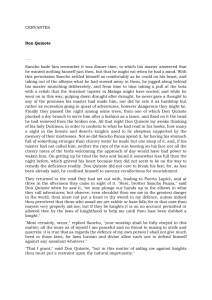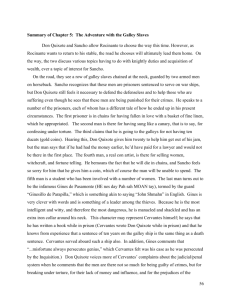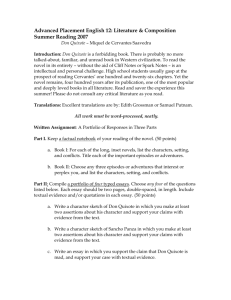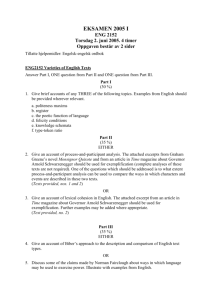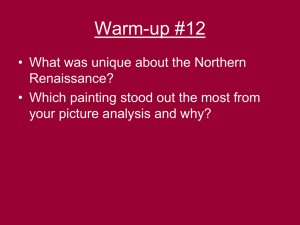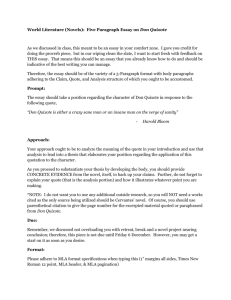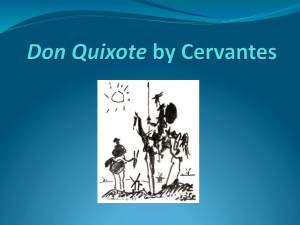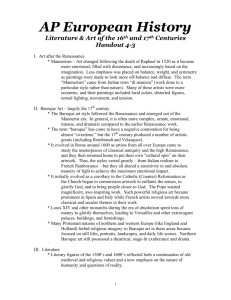Click here for a special Spring 2012 Don Quixote Study Guide!
advertisement
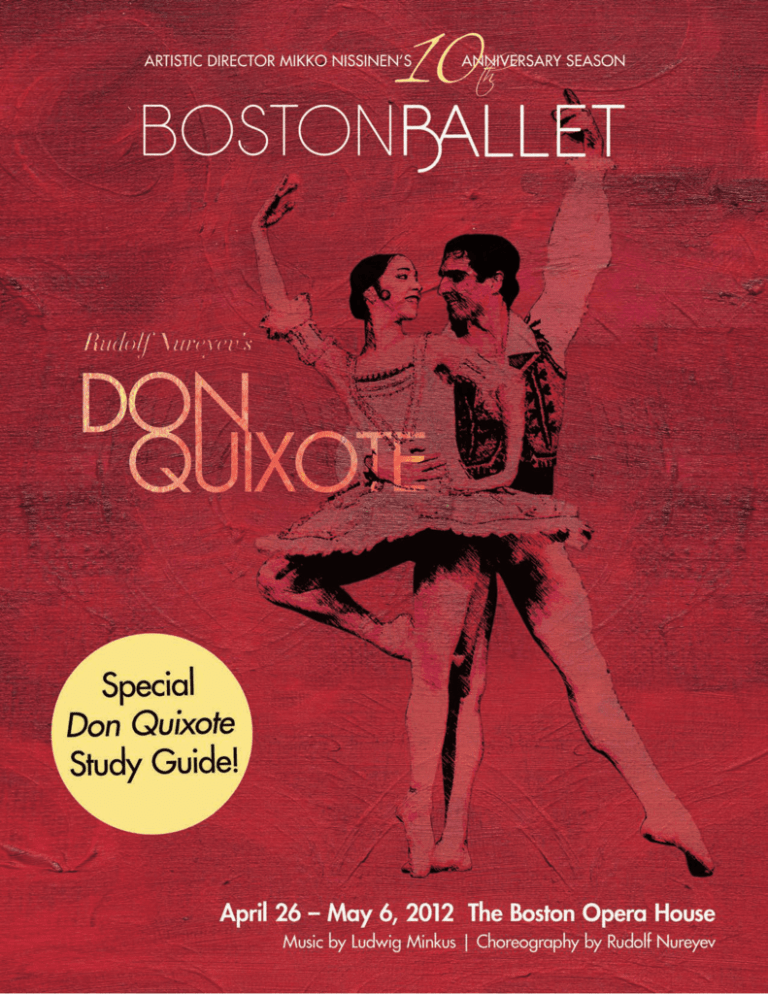
History This grand production of Don Quixote is full of virtuoso dancing and vibrant costumes and sets. Rudolf Nureyev first choreographed this version in Vienna in 1966. The tale is based on the Marius PetipaGorksy production, which was familiar to him from his time spent at the Kirov Ballet. This lively version has become one of Nureyev’s greatest successes. The story of Don Quixote has traveled to The Opera House Stage from the year 1602 when Miguel de Cervantes began writing the book. Cervantes wrote Don Quixote in two parts, published respectively in 1605 and 1615, during an historic period known as the Spanish Golden Age. During this time, Spain pursued military conquests in Europe and the Americas. This age brought great wealth to Spain and allowed the arts to flourish. Regarded by many as the first true novel ever written, Don Quixote was written as a parody on chivalry, a common theme during that period. Since then, Don Quixote has been regarded as a literary masterpiece, influencing many writers and inspiring numerous creations in various other genres, including opera, poetry, and ballet. Boston Ballet by Gene Schiavone Summary Don Quixote tells the story of an unlikely hero - a poor country gentleman who goes mad from reading too many novels and decides to put the world right by becoming a knight errant. But unlike the original novel, the focus of this ballet is not on the gallant knight, but instead on the romance between two of novel’s minor characters, Basilio and Kitri. The lovely Kitri is intent on marrying Basilio, a lowly barber, despite her father’s wishes to marry her off to the wealthy Gamache. As their romance faces trials, Don Quixote gallops alongside and provides his chivalrous assistance, all the while chasing his own illusions of love. SYNOPSIS Prologue: Don Quixote, a valiant and eccentric old gentleman, lies ill at his castle in Barcelona. He is surrounded by dust-covered books, and has been reading tales of the gallant knight errant. He dreams of the Lady Dulcinea, heroine of one of the stories, and in his delirium, vows to save her from her persecutors. His neighbor, Sancho Panza, pursued by two market women who have been sent to fetch him home, interrupts the Don’s delusions. Don Quixote enlists him as his squire and together they set out on their chivalrous adventures. ACT I: At the port of Barcelona, the lovely Kitri seeks out her sweetheart, the gallant young barber Basilio. Their happy meeting in the square is interrupted by Kitri’s father, the innkeeper Lorenzo, who tries to force her into accepting the hand of Gamache, a nobleman. She refuses, and with Basilio, takes part in the festivities of the townsfolk. Their joyous dancing is broken up by the arrival of the Don and Sancho Panza. The squire becomes the target of some horseplay by the villagers until his master rescues him. As Kitri dances with Basilio, Don Quixote imagines her to be Dulcinea and invites her to be his partner. Gamache is furious, but reluctantly joins with the crowd in supporting the Don’s hallucination. In the confusion that follows, Kitri and Basilio run off to get married, with Lorenzo and Gamache in hot pursuit. Don Quixote and Sancho Panza set out after them to right all the wrongs. ACT II – Scene I: Kitri and Basilio, seeking shelter in a windmill on the plain of Montiel, are captured by a troupe of gypsies who discover the lovers have nothing worth stealing. Instead, they seize and rob Lorenzo and Gamache. But with the sudden appearance of the Knight and his squire, they cooperate with Kitri and Basilio in a plot to set the Don against their pursuers. Their plans are foiled when Don Quixote is distracted by the windmills, which he takes for monsters and attacks with great courage – but unfortunate results. As the gypsies laugh at his defeat, the lovers run off with Lorenzo and Gamache at their heels. ACT II – Scene II: Lying unconscious from his wounds, Don Quixote dreams he is in a magic garden where the Queen of the Dryads brings the lovely Dulcinea to him. He declares his love for her. The dream fades and he sets off once more to find his lady, with the help of Sancho Panza. ACT III – Scene I: Kitri, Basilio, and their friends arrive at a tavern where they celebrate their escape. Lorenzo and Gamache appear, with Don Quixote and Sancho Panza close behind. Lorenzo is determined to marry his daughter to Gamache. In desperation, Kitri and Basilio decide to play one more trick on Don Quixote. Basilio pretends to stab himself in jealous despair, and Kitri implores the Don for help. In his pursuit to right a wrong, the Knight forces Lorenzo to bless the young lovers before they are parted forever. The indignant Gamache challenges the Don to a duel and is defeated. ACT III – Scene II: The lovers are united. As Don Quixote gives his blessing to Kitri and Basilio, he sees a vision of Dulcinea. With Sancho Panza still at his side, Don Quixote valiantly sets out once more to perform deeds of chivalry in Dulcinea’s service. CHARACTER LIST Don Quixote – a valiant and eccentric knight Lady Dulcinea – Don Quixote’s mythical love Sancho Panza – Don Quixote’s neighbor Kitri – lovely young townswoman, Basilio’s sweetheart Basilio – young barber, Kitri’s sweetheart Lorenzo – Kitri’s father, an innkeeper Gamache – a rich nobleman. Lorenzo wishes him to wed Kitri Lorna Feijoo by Gene Schiavone FUN FACTS • During Cervantes’ time, Latin was a language used by people that were highly educated. However, Cervantes didn’t write his novel in Latin; he wrote it in Castellano which was the language of the common people. • Cervantes made Don Quixote’s character very involved in reading books and the fictional world, so much so that he became a character in his own illusions and book. Boston Ballet by Gene Schiavone • Cervantes’ influence on the Spanish language cannot be underestimated, in fact it is often called la lengua de Cervantes. • At the time, the name Dulcinea meant “elegant sweetness.” To this day, a reference to someone as one’s “Dulcinea” implies hopeless devotion and unrequited love. ACTIVITIES I. Great books: A major theme in Don Quixote is the fantastic versus the realistic. Don Quixote is so involved in his stories of gallant knights and adventure that he begins to confuse his dreams with reality! 1. Do you ever feel so interested in a book that the characters begin to feel real? 2. What book made you feel this way? 3. Can you picture your favorite scene in a book you have read? How vividly? ACTIVITIES II. Word Search: Chivalry Dream Illusion Bravery Gypsy Dryad Don Quixote Kitri Basilio Lorenzo Gamache Barcelona Spain Horse Knights E ACTIVITIES III. Color a Windmill In Don Quixote’s delirious state, he mistakes the arms of a windmill for a monster. In La Mancha, Castilla, you can still see some of the old windmills that Don Quixote might have found in his adventures. The phrase “Tilting at Windmills,” comes from this memorable scene. The saying means attacking imaginary or non-existent enemies. Color this picture of a windmill at home before or after the show.
